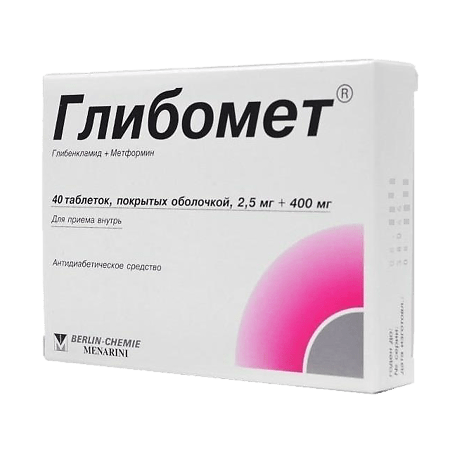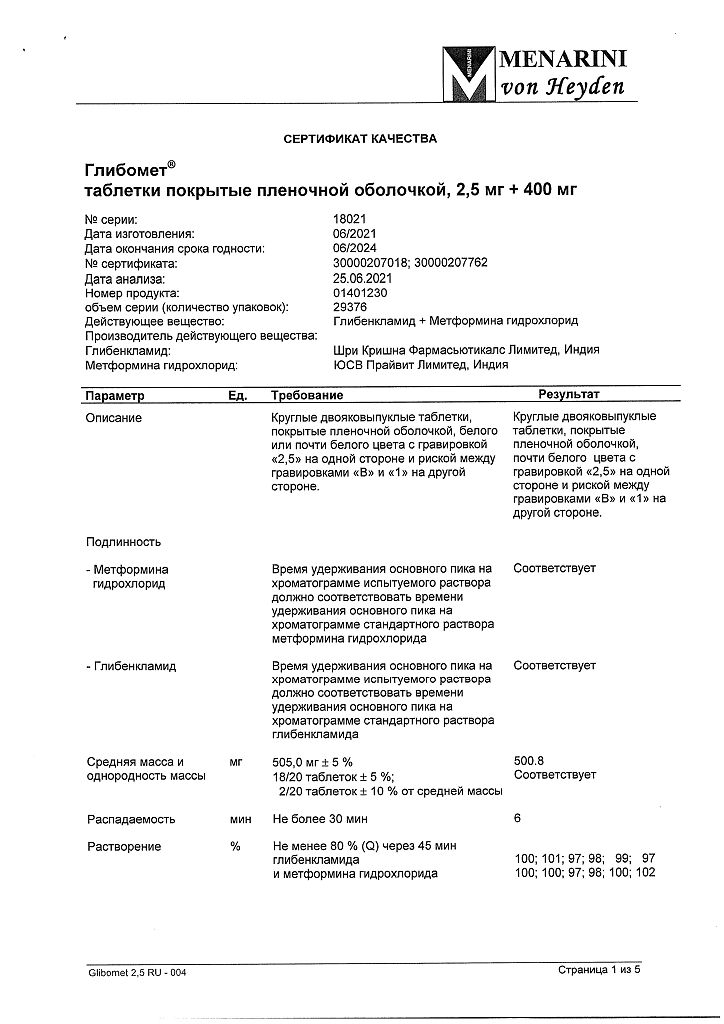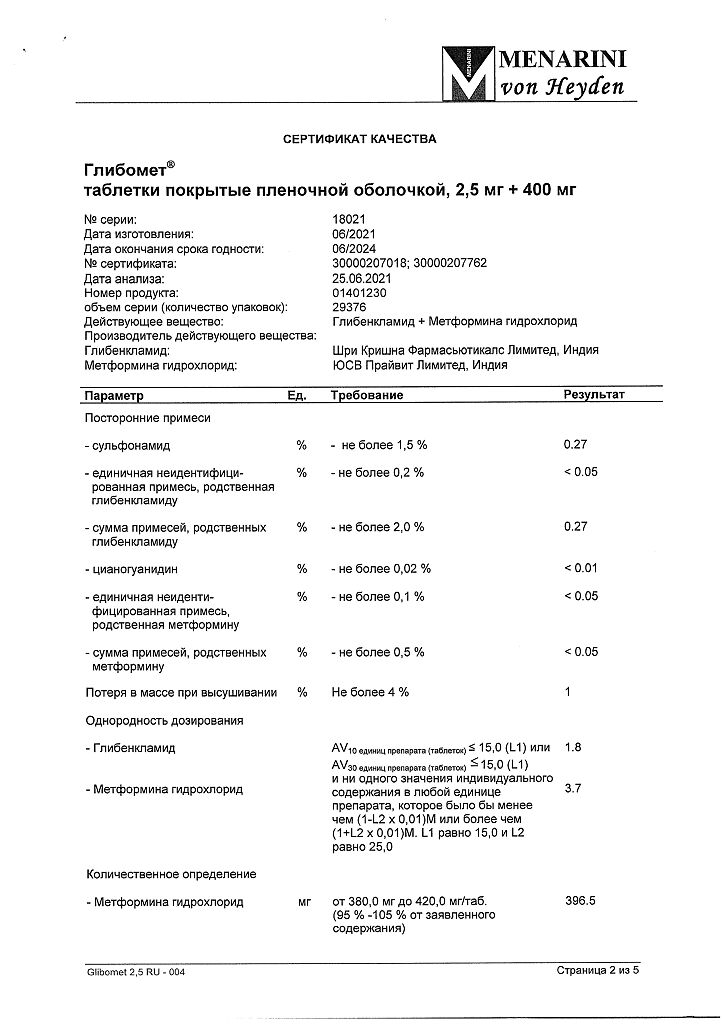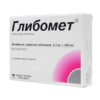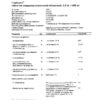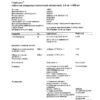No products in the cart.
Glybomet, 2.5mg+400 mg 40 pcs
€15.80 €13.17
Description
Glibomet® is an oral combined hypoglycemic agent, a sulfonylurea derivative of the II generation and bituanide. It has pancreatic and extrapancreatic effects.
Glibenclamide belongs to the group of sulfonylurea derivatives of the II generation. It stimulates insulin secretion by decrease of glucose irritation threshold of pancreatic beta cells, increases insulin sensitivity and extent of its binding to target cells, increases insulin release, increases insulin influence on glucose absorption by muscle and liver, inhibits lipolysis in adipose tissue. Acts in the second stage of insulin secretion.
Metformin belongs to the group of biguanides. It stimulates peripheral tissue sensitivity to insulin action (increases insulin binding to receptors, increases effects of insulin on postreceptor level), decreases glucose absorption in intestine, inhibits gluconeogenesis and favors lipid exchange, promotes reduction of excess body weight in diabetic patients, and has fibrinolytic effect due to inhibition of tissue plasminogen activator inhibitor.
Hypoglycemic effect of the drug develops in 2 hours and lasts 12 hours.
. Synergetic combination of two active components of the preparation – stimulating effect of sulfonylurea derivative on endogenous insulin production (pancreatic action) and direct effect of biguanide on muscle and fat tissue (significant increase in glucose assimilation – extrapancreatic action) and liver tissue (decrease of gluconeogenesis) – enables to reduce content of each component at certain dose ratio. This helps to avoid excessive stimulation of the beta cells of the pancreas and, therefore, reduce the risk of impairment of its function, and also provides increased safety of hypoglycemic drugs and reduced frequency of side effects.
Pharmacokinetics
. Glibenclamide is rapidly and fairly completely (84%) absorbed in the gastrointestinal tract (GIT), time to reach maximum concentration of 1-2 hours. Blood plasma protein binding is 97%. Almost completely metabolized in the liver with the formation of inactive metabolites. It is excreted by the kidneys – 50% and in the bile – 50%. Period of half-life is from 5 to 10 hours.
Metformin is completely absorbed in the gastrointestinal tract, rapidly distributed in tissues, practically does not bind with blood plasma proteins. It is not metabolized in the body and is excreted unchanged mainly by the kidneys and partially by the intestine. The elimination half-life is about 7 hours.
Indications
Indications
Diabetes mellitus type 2 (if diet therapy and previous therapy with sulfonylurea derivatives or biguanides, as well as other oral hypoglycemic agents are ineffective).
Pharmacological effect
Pharmacological effect
Glibomet® is an oral combined hypoglycemic agent, a derivative of a second generation sulfonylurea and bituanide. It has pancreatic and extrapancreatic effects.
Glibenclamide belongs to the group of sulfonylurea derivatives of the second generation. Stimulates insulin secretion by lowering the threshold for irritation of pancreatic beta cells by glucose, increases sensitivity to insulin and the degree of its binding to target cells, increases insulin release, enhances the effect of insulin on glucose uptake by muscles and liver, and inhibits lipolysis in adipose tissue. Acts in the second stage of insulin secretion.
Metformin belongs to the group of biguanides. Stimulates peripheral tissue sensitivity to the action of insulin (increases the binding of insulin to receptors, enhances the effects of insulin at the post-receptor level), reduces glucose absorption in the intestine, suppresses gluconeogenesis and has a beneficial effect on lipid metabolism, helps reduce excess body weight in patients with diabetes, and also has a fibrinolytic effect by suppressing tissue-type plasminogen activator inhibitor.
The hypoglycemic effect of the drug develops after 2 hours and lasts 12 hours.
The synergistic combination of two active components of the drug – the stimulating effect of a sulfonylurea derivative on the production of endogenous insulin (pancreatic effect) and the direct effect of biguanide on muscle and adipose tissue (a significant increase in glucose uptake – extrapancreatic effect) and liver tissue (decreased gluconeogenesis), allows, at a certain dose ratio, to reduce the content of each component. This helps to avoid overstimulation of pancreatic beta cells, and therefore reduce the risk of impaired pancreatic function, and also improves the safety of hypoglycemic drugs and reduces the incidence of side effects.
Pharmacokinetics
Glibenclamide is quickly and fairly completely (84%) absorbed in the gastrointestinal tract (GIT), the time to reach maximum concentration is 1-2 hours. The binding to plasma proteins is 97%. Almost completely metabolized in the liver with the formation of inactive metabolites. Excreted by the kidneys – 50% and with bile – 50%. The half-life ranges from 5 to 10 hours.
Metformin is absorbed quite completely from the gastrointestinal tract, quickly distributed into tissues, and practically does not bind to blood plasma proteins. It is not metabolized in the body and is excreted unchanged mainly by the kidneys and, partially, by the intestines. The half-life is approximately 7 hours.
Special instructions
Special instructions
During treatment, patients must strictly follow the doctor’s recommendations regarding the dosage and method of administration of the drug, as well as accompanying nutrition, exercise regimen and self-monitoring of plasma glucose concentrations.
Lactic acidosis is a rare and life-threatening pathological condition characterized by the accumulation of lactic acid in the blood, which may be caused by the accumulation of metformin. The described cases of the development of lactic acidosis in patients receiving metformin were observed mainly in patients with diabetes mellitus with severe heart and renal failure. Prevention of lactic acidosis involves identifying all associated risk factors, such as decompensated diabetes mellitus, ketosis, prolonged fasting, excessive alcohol consumption, liver failure and any condition associated with hypoxia.
When taking Glibomet®, serum creatinine concentrations should be regularly monitored:
– at least once a year in patients with normal renal function;
– at least 2-4 times a year in patients with serum creatinine concentrations close to the upper limit of normal, as well as in elderly patients. Caution should be exercised in cases where there is a risk of impaired renal function, for example, when prescribing antihypertensive or diuretic drugs, or when starting therapy with non-steroidal anti-inflammatory drugs (NSAIDs).
Treatment with Glibomet® should be stopped 48 hours before an x-ray examination with intravenous administration of iodine-containing contrast agents and replaced with therapy with other hypoglycemic agents (for example, insulin).
The use of the drug Glibomet® must be stopped 48 hours before a planned operation under general anesthesia with spinal or epidural anesthesia. Therapy should be continued after resumption of oral nutrition, or no earlier than 48 hours after surgery, provided normal renal function is confirmed.
Alcohol can provoke the development of hypoglycemia, as well as a disulfiram-like reaction (nausea, vomiting, abdominal pain, a feeling of heat on the face and upper body, tachycardia, dizziness, headache), therefore you should refrain from drinking alcohol during treatment with Glibomet®.
Effect of the drug on the ability to drive vehicles and other mechanisms
When taking the drug Glibomet®, hypoglycemia may develop, and, as a result, a decrease in the ability to concentrate and react; therefore, during treatment with Glibomet®, care should be taken when driving vehicles, machinery and engaging in potentially hazardous activities.
Active ingredient
Active ingredient
Glibenclamide, Metformin
Composition
Composition
Active ingredients:
metformin hydrochloride – 400 mg,
glibenclamide – 2.5 mg.
Excipients: core:
microcrystalline cellulose – 65.0 mg,
corn starch – 57.5 mg,
colloidal silicon dioxide – 20.0 mg,
gelatin – 40.0 mg,
glycerin (glycerol) -17.5 mg,
talc – 15.0 mg,
magnesium stearate – 7.5 mg.
Shell:
acetylphthalylcellulose – 2.0 mg,
diethyl phthalate – 0.5 mg,
talc – 2.5 mg.
Pregnancy
Pregnancy
The use of Glibomet® during pregnancy and breastfeeding is contraindicated.
Contraindications
Contraindications
hypersensitivity to metformin, glibenclamide or other sulfonylurea derivatives, as well as to other components of the drug;
type 1 diabetes mellitus;
gestational diabetes;
diabetic ketoacidosis, diabetic precoma, diabetic coma;
lactic acidosis (including history);
conditions accompanied by impaired absorption of food and the development of hypoglycemia;
liver dysfunction;
acute conditions that can lead to changes in kidney function: dehydration, severe infection, shock, intravascular administration of iodinated contrast agents;
renal failure or impaired renal function (creatinine level above 135 mmol/L for men and above 110 mmol/L for women);
infectious diseases, gangrene, major surgical interventions, trauma, acute massive blood loss, extensive burns and other conditions requiring insulin therapy;
hypoxic conditions (heart or respiratory failure, recent myocardial infarction, shock, severe respiratory diseases);
a period of 48 hours before and 48 hours after radioisotope or x-ray studies with the introduction of iodine-containing contrast agent;
period within 48 hours before and 48 hours after surgery;
dystrophic diseases (myotonic dystrophy, lipodystrophy);
leukopenia;
porphyria;
chronic alcoholism, acute alcohol intoxication;
adherence to a strict hypocaloric diet (less than 1000 kcal/day);
deficiency of glucose-6-phosphodehydrogenase;
pregnancy, breastfeeding period;
age up to 18 years.
It is not recommended to use the drug in people over 60 years of age who perform heavy physical work, which is associated with an increased risk of developing lactic acidosis.
With caution
febrile syndrome;
diseases of the thyroid gland (with dysfunction);
hypofunction of the anterior pituitary gland and/or adrenal cortex;
heavy physical work (risk of developing lactic acidosis).
Side Effects
Side Effects
From the digestive system:
Rarely: nausea, vomiting, loss of appetite, abdominal pain, diarrhea, metallic taste; in some cases: increased activity of liver enzymes.
From the hematopoietic system:
Rarely: leukopenia, thrombocytopenia, erythrocytopenia; very rarely, agranulocytosis, hemolytic or megaloblastic anemia, pancytopenia.
From the central nervous system:
Uncommon: headache.
From the skin:
Rarely: urticaria, erythema, itching, photosensitivity.
Metabolism:
Rarely: hypoglycemia.
Very rare: lactic acidosis.
If symptoms of lactic acidosis appear (vomiting, abdominal pain, general weakness, muscle cramps), you must immediately stop taking the drug and immediately consult a doctor.
Other: disulfiram-like reaction with simultaneous intake of alcohol (the most common symptoms: redness of the skin of the face and upper body, headache, nausea and vomiting, palpitations, increased blood pressure).
Interaction
Interaction
The hypoglycemic effect of Glibomet® is enhanced by concomitant use of coumarin derivatives (warfarin, syncumar), beta-blockers, cimitidine, oxytetracycline, allopurinol, monoamine oxidase inhibitors (MAO), sulfonamides, phenylbutazone and its derivatives, chloramphenicol, probenecid and salicylates, cyclophosamide, sulfonamide, perhexiline, pheniramidol, oral miconazole, sulfinpyrazone and alcohol.
Adrenaline, glucocorticosteroids, oral contraceptives, thyroid hormone preparations, thiazide diuretics and barbiturates reduce the hypoglycemic effect of Glibomet®.
With simultaneous use, the effect of anticoagulants may be enhanced.
Concomitant use with cimitidine may increase the risk of developing lactic acidosis. The use of beta-blockers may mask the symptoms of hypoglycemia (except for sweating).
The use of iodine-containing X-ray contrast agents (for intravascular administration) can lead to the development of renal dysfunction and accumulation of metformin, which increases the risk of developing lactic acidosis.
Overdose
Overdose
An overdose can provoke the development of lactic acidosis, since the drug contains metformin. Symptoms of lactic acidosis include severe weakness, muscle pain, respiratory problems, drowsiness, nausea, vomiting, diarrhea, abdominal pain, hypothermia, decreased blood pressure, reflex bradyarrhythmia, confusion and loss of consciousness. If the development of lactic acidosis is suspected, immediate discontinuation of the drug and emergency hospitalization are recommended.
The most effective method for removing lactate and metformin from the body is hemodialysis. An overdose can also lead to the development of hypoglycemia due to the presence of glibenclamide in the drug. Symptoms of hypoglycemia: feeling of hunger, increased sweating and palpitations, weakness, pallor of the skin, paresthesia in the oral cavity, tremor, general anxiety, headache, pathological drowsiness, sleep disorders, feelings of fear, impaired coordination of movements, temporary neurological disorders. As hypoglycemia progresses, the patient may lose self-control and consciousness.
For mild hypoglycemia, you should take a piece of sugar, food or drinks high in carbohydrates (jam, honey, a glass of sweet tea).
In case of loss of consciousness, it is necessary to administer 40-80 ml of a 40% dextrose (glucose) solution intravenously, then inject a 5-10% dextrose solution. You can then administer an additional 1 mg of glucagon intravenously (intramuscular or subcutaneous). If the patient does not regain consciousness, it is recommended to repeat these steps. If there is no effect, intensive therapy is indicated.
Storage conditions
Storage conditions
Store out of the reach of children at a temperature not exceeding 30°C.
Shelf life
Shelf life
3 years.
Manufacturer
Manufacturer
Berlin-Chemie AG, Germany
Additional information
| Shelf life | 3 years. |
|---|---|
| Conditions of storage | Keep out of reach of children at temperatures under 30 ° C. |
| Manufacturer | Berlin-Chemie AG, Germany |
| Medication form | pills |
| Brand | Berlin-Chemie AG |
Related products
Buy Glybomet, 2.5mg+400 mg 40 pcs with delivery to USA, UK, Europe and over 120 other countries.

